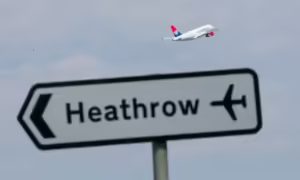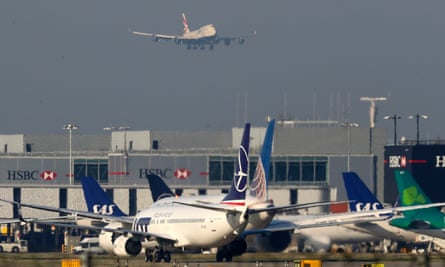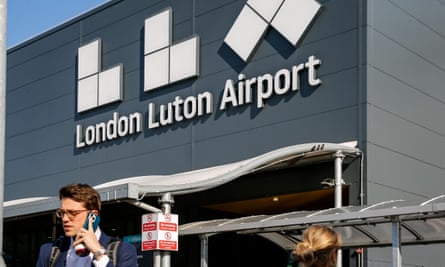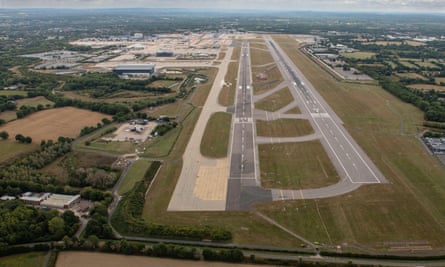Lobbyists are increasingly confident about expansion plans as concerns for the economy start to deepen

The aiport expansion lobby says bigger airports mean more trade, jobs and growth. But expansion doesn’t always mean new runways, such as the controversial plan for a third runway at Heathrow. Photograph: Daniel Leal-Olivas/PA
The younger, tormented minister mulling his position before the Labour government granted Heathrow’s third runway in 2009 might have been greatly relieved to know that, 15 years later, not a shovel would have touched the ground.
But now, returning to power with a revamped energy and climate brief, Ed Miliband again finds himself in a cabinet which, many in aviation hope, may usher in bigger airports and more flights – as well as enough CO2 emissions to outweigh any new solar farms.
Despite emerging victorious in political and legal battles over its plans for a third runway, Heathrow has dropped down the airport expansion queue. Among London airports alone, City has just been granted permission to expand passenger numbers by 40%, while Luton and Gatwick await ministerial decisions on large developments that would add huge numbers of flights.
Net zero may still be the government’s stated ambition, but the messages ringing louder in airport executives’ ears are those from the chancellor, Rachel Reeves, stressing growth and planning reforms to get Britain building infrastructure again – particularly the type not funded by the battered public purse. A pre-election interview in which Reeves underlined she had “nothing against expanding airport capacity … I back our airports” was noted.

Growth doesn’t necessarily mean new runways. Airports’ passenger capacities are often limited in original planning conditions, which several hope to amend. Bigger planes and extended flight hours, as well as reconfigured buildings and more efficient operations, can all bring more customers through. Manchester and Birmingham are growing with terminal renovations, while a large extension to Stansted’s terminalfollows the airport’s legal victory in pushing its permitted capacity to 43 million passengers a year.
Britain’s operators might not yet have the brass neck of Ireland’s Dublin airport which, its Ryanair-schooled CEO Kenny Jacobs announced last week, would simply be breaking its licensed 32m limit this year, and hadn’t checked the sanctions. “We’re in uncharted territory”, Jacobs said.
But the operators would certainly echo his accompanying sentiments: that bigger airports mean trade, jobs and growth. Jacobs claimed that meeting the threshold, by turning away a million passengers in 2025, would lose Ireland €500m (£420m) in visitor spending and cost 1,000 jobs.
Similar figures are bandied around in south-east England by Gatwick, which has rebranded an existing taxiway as a standby “northern runway” as it seeks permission for the kind of expansion ruled out last decade by the Airport Commission. Tim Norwood, Gatwick’s chief planning officer, said the runway plans “will be a major contributor to our airport’s long-term growth and will deliver a significant boost to the region, by generating 14,000 new jobs and £1bn for the economy every year”.

A planning inspector’s report will land on the transport secretary Louise Haigh’s desk in November, for a decision early in 2025. Before that, Haigh must rule on Luton’s masterplan to fly 32 million passengers a year, up from the current 19 million maximum, by adding a terminal and expanding into a neighbouring park.
Paul Kehoe, chair of Luton Rising, the council-owned company that runs the airport, said the proposal would make “best use of the airport’s existing runway and assets and play a crucial role in stimulating regional economic growth by enhancing trade, attracting investment and boosting tourism – generating an additional £1.5bn in economic activity every year by the mid-2040s”. It would bring 11,000 jobs at the airport, he added.
Will these applications succeed? According to one industry source, “The mood music is positive … There’s something in the air.” And not just another jet to the Balearics.
Labour’s manifesto had none of the measures to curb aviation proposed by the Liberal Democrats or Greens, and decisions on these large privately funded infrastructure projects are expected to be led by the Treasury rather than the DfT.
Officially, all expansion has to meet the party’s four tests, three of which are environmental: would a bigger airport harm air quality; increase noise; and still allow Britain to meet its climate change targets. But the fourth, whether it brings countrywide economic benefits, is the one that suddenly seems the most germane to policymakers.
The industry insists that the environment will not be simply shunted aside for the economy. AirportsUK, the renamed trade body for the operators, said international flights were “important enablers of economic growth, and will play an important role in delivering the government’s ambition to have the fastest rate of growth in the G7”; and that airport expansion “would directly create jobs, inject investment into all areas of the UK and stimulate trade and investment”. But, it said, “airports can expand while meeting net zero commitments” and should be allowed “to grow sustainably, subject to planning and environmental requirements”.
Most environmental groups, of course, disagree. Opposition to expansion has in no way been softened by the greatest current hope of “sustainable aviation”: its eponymous fuels (SAF).
Others argue that the economic arguments are fundamentally flawed. Alex Chapman of the thinktank the New Economics Foundation says: “If we are saying airport expansion drives growth, what is the mechanism? Typically most of the modelling suggests it is through business travellers and trade. But the statistics show that there has been no net increase in business travel since 2006, when capacity has grown dramatically. All the growth has come from the leisure market.

“That poses serious questions for those who argue airports deliver growth. It’s not clear that residents flying overseas for holidays is of any economic benefit to the UK.”
Data published by Visit Britain this month showed domestic tourism declining by 5% year on year, with spending down 9%, hitting the regions hardest, as outbound trips boomed.
A longstanding campaigner for Labour and on transport issues, who declined to be named, said: “Within a lot of Labour, there’s a reflex belief in the voodoo economics pushed by the airports.”
Now though, he said: “There is another group of very senior Labour politicians who do understand the environmental implications, in a way ministers didn’t 20 years ago.”
While the Ed Miliband of 2024 has rapidly approved massive renewable energy projects, Chapman warns: “All of that progress in terms of carbon emissions on onshore wind and solar is likely to be immediately wiped out by one or two airport expansions.”
And the shadow of the big one, Heathrow, looms again. Heathrow declined to comment for this feature, but its chief executive, Thomas Woldbye, said in July that the airport was hoping to get “more capacity out of the existing infrastructure”, while also working on new runway plans.
Paul Beckford, policy director at anti-Heathrow expansion group, Hacan, said: “All of these other southeast airport expansions combined don’t equate to the size of Heathrow’s expansion in its size or climate impact … Building Heathrow’s third runway would be like plonking Gatwick next to the existing site.”
A Department for Transport spokesperson said: “We are committed to securing the long-term future of the UK’s aviation sector.
“However, all expansion proposals must demonstrate they contribute to economic growth, while remaining in line with existing environmental obligations.”


